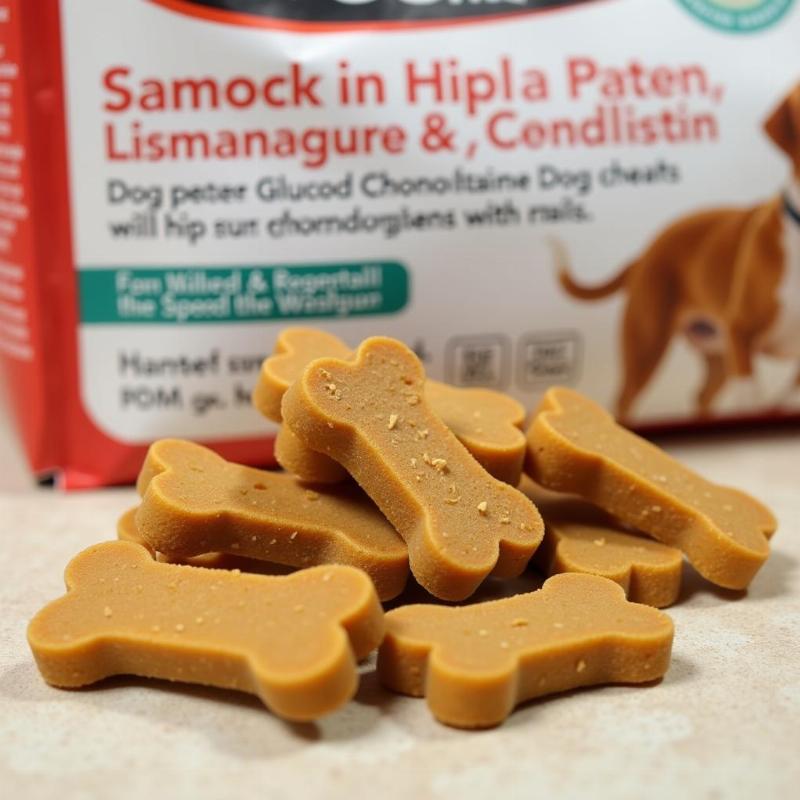Hip and joint issues are a common concern for dog owners in the US, especially as our furry friends age. These problems can range from mild stiffness to debilitating arthritis, significantly impacting a dog’s quality of life. Fortunately, hip and joint treats can provide support and relief, helping your dog stay active and comfortable. This comprehensive guide will delve into the world of hip and joint treats, covering everything from understanding the ingredients to choosing the right product for your canine companion.
Understanding the Ingredients in Hip & Joint Treats for Dogs
Choosing the right hip and joint treats involves understanding the key ingredients that offer therapeutic benefits. Glucosamine and chondroitin are two of the most common and effective ingredients, supporting cartilage health and reducing inflammation. Other beneficial ingredients include MSM (methylsulfonylmethane), a natural anti-inflammatory, and omega-3 fatty acids, known for their joint-lubricating properties. Look for treats that contain a balanced combination of these ingredients for optimal results.
 Glucosamine and Chondroitin Dog Treats
Glucosamine and Chondroitin Dog Treats
Many hip and joint treats also incorporate natural ingredients like turmeric, green-lipped mussel, and yucca, which possess anti-inflammatory and pain-relieving properties. While these ingredients can be beneficial, it’s essential to consult with your veterinarian to ensure they don’t interact with any existing medications your dog is taking.
Choosing the Right Hip & Joint Treats: A Guide for US Dog Owners
The US market offers a wide variety of hip and joint treats for dogs, making the selection process overwhelming. Consider your dog’s age, breed, size, and specific needs when making your choice. For large breeds prone to hip dysplasia, look for treats with higher concentrations of glucosamine and chondroitin. Senior dogs might benefit from treats with added antioxidants to combat age-related cell damage.
Always prioritize quality and safety when selecting treats. Look for products made in the USA with human-grade ingredients and avoid treats containing artificial colors, flavors, or preservatives. The American Kennel Club (AKC) offers resources and recommendations for choosing safe and effective dog treats.
How Hip and Joint Treats Can Help Your Dog
Hip and joint treats can significantly improve your dog’s mobility and overall well-being. By providing essential nutrients and anti-inflammatory compounds, these treats can help reduce pain, stiffness, and inflammation associated with conditions like arthritis, hip dysplasia, and osteoarthritis. Regular use can also help support cartilage regeneration and maintain healthy joint function.
“Hip and joint treats are an excellent preventative measure for younger dogs, especially those predisposed to joint issues,” says Dr. Emily Carter, DVM, a certified veterinary orthopedist. “For older dogs, these treats can significantly improve their quality of life by managing pain and promoting mobility.”
Conclusion: Keeping Your Dog’s Hips and Joints Healthy
Hip and joint treats are a valuable addition to any dog’s wellness routine, offering targeted support for joint health and mobility. By understanding the key ingredients, choosing high-quality products, and consulting with your veterinarian, you can help your dog stay active, comfortable, and pain-free for years to come. Remember to consider factors like breed, age, and specific needs when selecting the best hip and joint treats for your beloved companion.
FAQ
-
When should I start giving my dog hip and joint treats? While it’s never too late to start, introducing hip and joint treats proactively, even in younger dogs, can help prevent future joint issues.
-
How many hip and joint treats should I give my dog? Always follow the manufacturer’s recommended dosage.
-
Are hip and joint treats a substitute for veterinary care? No, hip and joint treats are a supplement to veterinary care, not a replacement.
-
Can I give my dog human glucosamine and chondroitin supplements? No, always use products specifically formulated for dogs.
-
What are the signs of joint pain in dogs? Signs include stiffness, limping, reluctance to exercise, and difficulty getting up or down.
-
How long does it take to see results from hip and joint treats? Results vary, but you may notice improvements in your dog’s mobility and comfort within a few weeks of consistent use.
-
Are there any side effects of hip and joint treats? Side effects are rare but can include mild digestive upset.
Beautdogs.us is your trusted source for comprehensive information on dog care, breed-specific advice, and product recommendations. We provide expert guidance for both new and experienced dog owners, ensuring your furry friend receives the best possible care. Visit Beautdogs.us for more valuable insights into the world of canine companionship. Contact us at [email protected] or +1 501-555-7529 for personalized support.